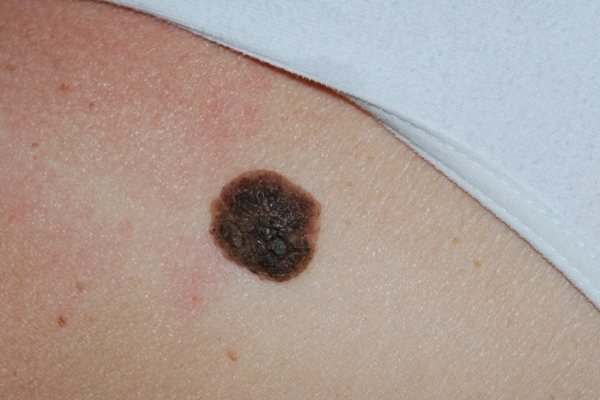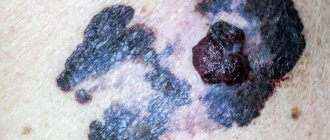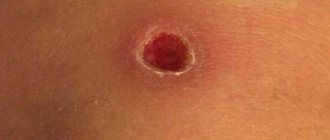Reasons for the development of malignant processes
In the vast majority of cases, patients are faced with ordinary papillomas or vulgar warts, which are the same thing. Such growths are not dangerous to health, although they do not look aesthetically pleasing. Their development is provoked by virus strains with minimal risk of developing cancer.
At the same time, doctors know about 100 types of human papillomavirus, about 10 of them can provoke the development of cancer. First of all, types 16 and 18 of the virus are isolated. It is these two types that provoke the development of cervical cancer in women.
The danger of HPV lies in the fact that when infected, the virus does not immediately manifest itself. When an oncogenic strain enters a woman’s body, there may be no visible manifestations of the disease for a long period. In this case, papillomas appear on the vaginal mucosa and cervix, but there may be no growths on the skin of the body. Typically, this form of the disease is diagnosed accidentally during a routine examination by a gynecologist. Having discovered a tumor on the cervix, the doctor sends the patient for tests, the results of which reveal HPV.
Some types of HPV are relatively harmless, while others can cause cancer.
Why did the papilloma turn black?
Warts or papillomas are benign formations of viral etiology that grow from the epithelium and rise above the surface of the surrounding tissue. They do not have much impact on health. However, there are times when, for no apparent reason, changes occur to the normal appearance of the growth. And also in case of accidental or intentional injury, as a result of which the papilloma turns black. What to do in such cases and what do you need to know to protect yourself from potential danger? This article will help answer these questions.
Vulgar warts and cancer
Malignant papilloma does not only appear in the vagina. For a number of reasons, an ordinary papilloma, provoked by a harmless type of virus, can begin to degenerate into a malignant formation.
Malignant papilloma in this case appears as a result of:
- skin damage;
- exposure to ultraviolet radiation;
- papilloma infections;
- inflammatory process in the body;
- general decrease in immunity.
The process of degeneration of a benign growth into a malignant papilloma on the skin of the body is accompanied by a number of specific symptoms that are difficult not to pay attention to. Having noticed any changes, it is important to visit a doctor as soon as possible and examine the growth that is disturbing the patient.
Any damage to the growth body can trigger the process of cell degeneration. Malignant papilloma can form due to prolonged exposure to ultraviolet rays.
What measures should be taken
After the growth spontaneously falls off, doctors advise patients to adhere to the following tactics:
- Antiseptic solution
Treat the pathological lesion with an antiseptic solution. An antiseptic will not allow pathogens to multiply, causing inflammation and suppuration; - Protecting the area from tap water will speed up the regeneration process. For this purpose, you can use a medical plaster;
- If the tumor falls off, you need to save it and show it to the doctor. He will send the tissue for examination to assess the nature of the neoplasm and rule out cancer;
- If there is bleeding, you need to stop the bleeding by applying a bandage of sterile bandage and cotton wool.
If the papilloma turns black and falls off on its own, the prognosis is most often favorable, especially if the process is not accompanied by pain.
But even in this case, it is necessary to visit a doctor, who, after examination, will determine whether there are any root residues left in the soft tissues.
Important! If the skin at the site of the fallen tumor has not undergone any changes, this is a sign that the focus of the virus has died and the disease will not resurface in this area.
If a darkened and dried papilloma does not come off on its own, but continues to cause discomfort, it is necessary to seek medical help as soon as possible.
Blackened papilloma
The specialist will prescribe the necessary diagnostic measures to find out the characteristics of the tumor and make a prognosis for the disease.
Signs and symptoms of malignant papilloma
Having figured out whether papilloma can be malignant, it is important to be able to recognize the beginning of the pathological process in the cells of the growth. Usually the process of degeneration is accompanied by characteristic signs of malignant papilloma. Among them:
- sudden change in color of the growth;
- increase in size;
- discomfort in the area of papilloma;
- discharge of pus, blood or ichor from the head of the wart;
- throbbing pain;
- the appearance of a putrid odor.
Types of papillomas
There are more than a hundred types of human papillomas. But, fortunately, only five of them appear on human skin and mucous membranes.
The main types of benign growths:
- Simple neoplasms that appear on the hands. Such growths can exist for several decades and then disappear without a trace. They most often occur in children during adolescence.
- Flat papillomas that form on the hands, face and neck.
- Plantar neoplasms that cause the patient severe pain when walking.
- Filiform papillomas, which most often form in older people. Neoplasms are localized in the eye area, as well as in the armpits, neck and groin.
- Pointed growths or condylomas. Such benign tumors occur on the genital organs and pose the greatest danger, since they can degenerate into a cancerous tumor.
Most often, the growths have a soft structure and a flesh or dark flesh color. But sometimes papillomas turn black and begin to hurt. Let's try to understand the reasons for the change in color of tumors.
When to see a doctor?
If you notice the appearance of a nonspecific papilloma on the skin, which differs in color or size from benign growths, you should contact an oncologist.
Damage to the wart at home is also a cause for concern. It can be accidentally scratched with nails, rubbed with clothing, or cut off with a razor. Normally, such damage does not cause complications, but the cells of some papillomas can develop into cancer.
Dermatologists warn: any papilloma that interferes with everyday life or causes discomfort must be removed. Otherwise, repeated damage to the integrity of the growth may trigger the onset of pathological cell degeneration.
If the formation is inflamed, what should you do?
In case of inflammatory processes, at a minimum, you should pay attention to the growth, and ideally, start treatment, preferably under the supervision of specialists. Causes for concern:
- papilloma changes color;
- hardens;
- increases in size;
- itching appears;
- a burning sensation is felt;
- injury occurred.
Sometimes, a simple papilloma can develop into an oncological tumor. This happens rarely, with a very weak immune system, but it is better to protect yourself - strengthen the immune system by consuming vitamin complexes.
Diagnosis of cancer
If you suspect a malignant papilloma, you should undergo a series of examinations. First of all, the doctor will examine the growth using a special device that magnifies the image many times. Pathology can be suspected by visual examination, based on structural changes in papilloma skin cells.
Then you need to take a PCR test, which determines the types of papillomaviruses. The next step is removal of the wart for the purpose of histological examination of the cells. Treatment for the disorder begins only after confirmation of the diagnosis.
First aid for blackened papilloma

If a modification of the neoplasm is detected, first of all you need to examine it. A person should carefully monitor whether the wart is bleeding, whether there is pain when palpating around it, and whether traces of mechanical damage are visible on it.
If the wart turns black and falls off without any consequences, several precautions must be taken:
- the wound that appears in the place where the papilloma was is treated with any antiseptic (Panthenol, peroxide, alcohol, Miramistin);
- the damaged area is sealed with adhesive tape and protected from moisture;
- the fallen off dark growth is placed in a box and taken to the hospital for histological analysis.
If the wart has dried out and started to fall off after chemotherapy or treatment with topical drugs, then there is no need to worry. The most important thing is to monitor the condition of the epidermis and, when the first signs of inflammation appear, immediately go to the doctor.
Regardless of why the wart has turned black or dried out, under no circumstances should you tear it off by force. Modern medicine has many medicines that can easily remove it without risk to health, so there is no point in performing a “surgery” at home.
When a papilloma is torn off, the following can happen:
- a huge wound will remain on the body, which may subsequently enlarge or heal unsightly, leaving behind a scar;
- if the tumor is damaged, severe bleeding will begin;
- Only the tip of the wart can come off and become infected, which will cause extensive tissue necrosis, accompanied by an inflammatory process.
Therefore, even if the course of treatment for papilloma comes to an end, but it still does not disappear, it is forbidden to take the initiative. The therapy may need to be continued until it completely dries and separates from the skin.
Treatment principle
Treatment of malignant papilloma consists of its removal. To do this, use any of the professional methods - cryodestruction, laser burning, electrocoagulation. If malignant cells are found in the growth, the skin around the growth is further examined. When the pathological process spreads to healthy tissue, traditional oncology treatment methods are prescribed - radiation and chemotherapy.
For papillomas on the mucous membrane of the genital organs, treatment also begins with removal of the growth and examination of its tissue. A biopsy is not performed if a malignant papilloma is suspected. This procedure is accompanied by cell damage, which can negatively affect the rate of development of the pathological process. If cancer is confirmed, comprehensive treatment is carried out by an oncologist.
Additionally, the patient may be prescribed antiviral drugs that suppress the activity of the virus. This is necessary to avoid relapse after chemotherapy. It is strictly not recommended to try to remove papilloma that has changed color or shape on your own at home. In case of cancer, available means for removing warts (alkalis, acids, celandine juice) greatly increase the health risk.
Danger to others
The occurrence of papilloma cannot be ignored, especially if it has changed its pigmentation. A doctor's intervention is required. Cases when several types of virus are present in the body at once deserve special attention. An infected person poses a threat to others. First of all, those closest to you.
For example, a mother with formations on the genitals often infects the child at birth. In addition, being together in a public place, especially one with high humidity, exposes the environment to an increased attack by HPV. Papillomavirus cannot be completely removed from the body. However, maintaining the immune system in good condition will prevent the disease from manifesting itself.
The neoplasm may turn black even if it has died and will disappear in the near future. Why is this happening? Because the human immune system was still able to overcome the virus.
The growth is swollen and painful
In the case when the papilloma turns black and hurts, the skin around it is inflamed and hot, we can talk about infection. Therefore, it is necessary to urgently treat the wound to avoid suppuration.
The papilloma turns black, does not hurt, does not increase in size, is not inflamed, there is no local temperature, but has it disappeared on its own? All this speaks of self-healing. Carefully observe the area where the growth was located for a while, and if there are any changes, consult a dermatologist.
Another option for the natural death of a wart. The papilloma has turned black and dried out, does not hurt or become inflamed, but does not fall off. In this case, you also need to contact a dermatologist. Perhaps the top layer died, but the pathological process did not end.
Treatment of inflamed warts with medications
Treatment of an inflamed growth requires a whole range of measures and consists of taking antiviral drugs, using immunomodulators, as well as drugs that will eliminate skin defects.
Destructive type therapy can be performed only in two ways, namely:
- Conservative method - uses medications that can be purchased at a pharmacy.
- Radical method - carried out by the attending physician directly in the hospital.
Conservative methods of treating inflamed warts include:
- The use of antiseptics that do not have a colored pigment. The affected area of skin is treated with it and covered with a bactericidal plaster on top to prevent secondary infection from occurring. Under no circumstances should you use brilliant green, iodine or blue.
- If bleeding occurs, then the treatment method that is usually used to stop capillary hemorrhages is used. The wound is treated with peroxide, Miramistin and sealed with a bandage on top, or it can be bandaged for convenience.
If, in addition to the inflammatory process, there is severe pain, the wart begins to grow, the skin turns red, but there is no bleeding, then the growth does not need to be treated.
Sometimes during treatment a small piece of the papilloma may fall off. It must be saved to show it to a dermatologist for examination.
These methods are considered temporary, and you cannot do without a subsequent visit to the doctor, because in any case the growth will need to be removed. You should not self-medicate, as this can lead to serious complications or even death.
Causes of darkening
If black papilloma is observed, the cause should be identified. Experts identify factors that provoke such a change:
- emerging inflammation, infection;
- injury;
- rubbing with clothes, shoes;
- consequences of self-removal, burning with traumatic compounds of vinegar, alkaline mixtures;
- darkening occurred after taking certain medications. Dries out and may fall off on its own;
- improvement of the immune system - suppression of HPV, papillomas turn black and disappear;
- hemangioma formation.
DETAILS: Apple cider vinegar for papillomas and condylomas

The result of unconventional methods of removing formations may be its blackening.
If there are no accompanying alarming symptoms, there is no need to worry. After some time, the wart will fall off on its own, leaving no traces.
If, after using traditional medicine, the affected area is swollen, painful, or discharge from the head appears, it is recommended to consult a specialist. In this case, it is impossible to predict a favorable outcome in the absence of proper treatment and medical supervision.











